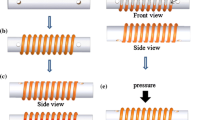Abstract
A copper pad oxidizes easily at elevated temperatures during thermosonic wire bonding for chips with copper interconnects. The bondability and bonding strength of a gold wire onto a bare copper pad are seriously degraded by the formation of a copper oxide film. A new bonding approach is proposed to overcome this intrinsic drawback of the copper pad. A silver layer is deposited as a bonding layer on the surface of copper pads. Both the ball-shear force and the wire-pull force of a gold wire bonded onto copper pads with silver bonding layers far exceed the minimum values stated in the JEDEC standard and MIL specifications. The silver bonding layer improves bonding between the gold ball and copper pads. The reliability of gold ball bonds on a bond pad is verified in a high-temperature storage (HTS) test. The bonding strength increases with the storage time and far exceeds that required by the relevant industrial codes. The superior bondability and high strength after the HTS test were interpreted with reference to the results of electron probe x-ray microanalyzer (EPMA) analysis. This use of a silver bonding layer may make the fabrication of copper chips simpler than by other protective schemes.
Similar content being viewed by others
References
J. Ida, M. Yoshimaru, T. Usami, A. Ohtomo, K. Shimokawa, A. Kita, and M. Ino, Proc. VLSI Technology Symp. (1994), pp. 59–60.
M. Miyamoto, T. Takeda, and T. Furusawa, IEEE Trans. Electron Dev. 44, 250 (1997).
G. Deltoro and N. Sharif, 24th IEEE/CPMT (Piscataway, NJ: IEEE, 1999), pp. 185–188.
C.L. Chuang, J.N. Aoh, and R.F. Din, Microelectron. Reliab. 46, 449 (2006).
J.N. Aoh and C.L. Chuang, J. Electron. Mater. 33, 310 (2004).
T.A. Tran and L. Yong, S. Chen, and A. Chen, IEEE Electronic Components and Technology Conf. (Piscataway, NJ: IEEE, 2000), pp. 1674–1680.
J.F. Rohan, G. O’Riordan, and J. Boardman, Appl. Surf. Sci. 185, 289 (2002).
H.S. Chang, J.X. Pon, K.C. Heien, and C.C. Chen, J. Electron. Mater. 30, 1171 (2001).
J.N. Aoh and C.L. Chuang, J. Electron. Mater. 33, 299 (2004).
J. Aday, R.W. Johnson, J.L. Evans, and C. Romaczuk, Int. J. Microcirc. Electron. Packaging 17, 302 (1994).
T.Y. Lin, K.L. Davison, W.S. Leong, S. Chua, Y.F. Yao, J.S. Pan, J.W. Chai, K.C. Toh, and W.C. Tjiu, Microelectron. Reliab. 43, 803 (2003).
Wire Bond Shear Test, EIA/JESD22-B116 (Arlington, VA: Electronic Industrial Alliance, 1998).
MIL-STD-8836, “Test Method Standard Microcircuits,” Method No. 2011.7, Bonding Strength (Destructive Bond Pull Test), Department of Defense, USA, February 2006.
Author information
Authors and Affiliations
Rights and permissions
About this article
Cite this article
Chuang, CL., Aoh, JN. Thermosonic bonding of gold wire onto silver bonding layer on the bond pads of chips with copper interconnects. J. Electron. Mater. 35, 1693–1700 (2006). https://doi.org/10.1007/s11664-006-0220-z
Received:
Accepted:
Issue Date:
DOI: https://doi.org/10.1007/s11664-006-0220-z



